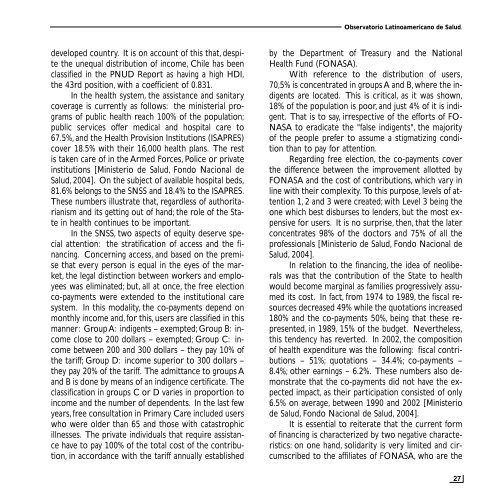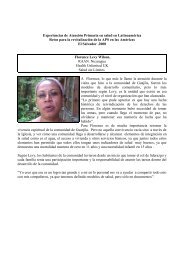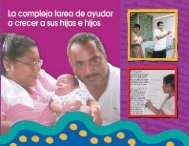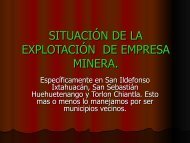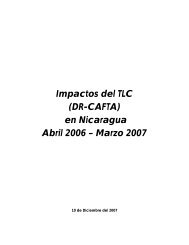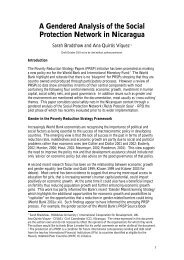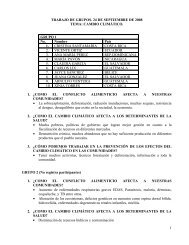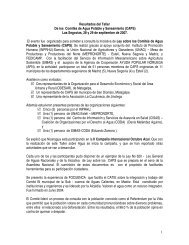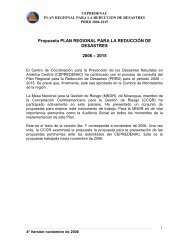Download - CISAS | Centro de Información y Servicios de AsesorÃa ...
Download - CISAS | Centro de Información y Servicios de AsesorÃa ...
Download - CISAS | Centro de Información y Servicios de AsesorÃa ...
Create successful ePaper yourself
Turn your PDF publications into a flip-book with our unique Google optimized e-Paper software.
Observatorio Latinoamericano <strong>de</strong> Salud.<strong>de</strong>veloped country. It is on account of this that, <strong>de</strong>spitethe unequal distribution of income, Chile has beenclassified in the PNUD Report as having a high HDI,the 43rd position, with a coefficient of 0.831.In the health system, the assistance and sanitarycoverage is currently as follows: the ministerial programsof public health reach 100% of the population;public services offer medical and hospital care to67.5%, and the Health Provision Institutions (ISAPRES)cover 18.5% with their 16,000 health plans. The restis taken care of in the Armed Forces, Police or privateinstitutions [Ministerio <strong>de</strong> Salud, Fondo Nacional <strong>de</strong>Salud, 2004]. On the subject of available hospital beds,81.6% belongs to the SNSS and 18.4% to the ISAPRES.These numbers illustrate that, regardless of authoritarianismand its getting out of hand; the role of the Statein health continues to be important.In the SNSS, two aspects of equity <strong>de</strong>serve specialattention: the stratification of access and the financing.Concerning access, and based on the premisethat every person is equal in the eyes of the market,the legal distinction between workers and employeeswas eliminated; but, all at once, the free electionco-payments were exten<strong>de</strong>d to the institutional caresystem. In this modality, the co-payments <strong>de</strong>pend onmonthly income and, for this, users are classified in thismanner: Group A: indigents – exempted; Group B: incomeclose to 200 dollars – exempted; Group C: incomebetween 200 and 300 dollars – they pay 10% ofthe tariff; Group D: income superior to 300 dollars –they pay 20% of the tariff. The admittance to groups Aand B is done by means of an indigence certificate. Theclassification in groups C or D varies in proportion toincome and the number of <strong>de</strong>pen<strong>de</strong>nts. In the last fewyears, free consultation in Primary Care inclu<strong>de</strong>d userswho were ol<strong>de</strong>r than 65 and those with catastrophicillnesses. The private individuals that require assistancehave to pay 100% of the total cost of the contribution,in accordance with the tariff annually establishedby the Department of Treasury and the NationalHealth Fund (FONASA).With reference to the distribution of users,70,5% is concentrated in groups A and B, where the indigentsare located. This is critical, as it was shown,18% of the population is poor, and just 4% of it is indigent.That is to say, irrespective of the efforts of FO-NASA to eradicate the "false indigents", the majorityof the people prefer to assume a stigmatizing conditionthan to pay for attention.Regarding free election, the co-payments coverthe difference between the improvement allotted byFONASA and the cost of contributions, which vary inline with their complexity. To this purpose, levels of attention1, 2 and 3 were created; with Level 3 being theone which best disburses to len<strong>de</strong>rs, but the most expensivefor users. It is no surprise, then, that the laterconcentrates 98% of the doctors and 75% of all theprofessionals [Ministerio <strong>de</strong> Salud, Fondo Nacional <strong>de</strong>Salud, 2004].In relation to the financing, the i<strong>de</strong>a of neoliberalswas that the contribution of the State to healthwould become marginal as families progressively assumedits cost. In fact, from 1974 to 1989, the fiscal resources<strong>de</strong>creased 49% while the quotations increased180% and the co-payments 50%, being that these represented,in 1989, 15% of the budget. Nevertheless,this ten<strong>de</strong>ncy has reverted. In 2002, the compositionof health expenditure was the following: fiscal contributions– 51%; quotations – 34.4%; co-payments –8.4%; other earnings – 6.2%. These numbers also <strong>de</strong>monstratethat the co-payments did not have the expectedimpact, as their participation consisted of only6.5% on average, between 1990 and 2002 [Ministerio<strong>de</strong> Salud, Fondo Nacional <strong>de</strong> Salud, 2004].It is essential to reiterate that the current formof financing is characterized by two negative characteristics:on one hand, solidarity is very limited and circumscribedto the affiliates of FONASA, who are the27


